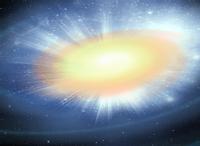There’s gold in them there Gamma Ray Bursts
 A collaboration between the Universities of Warwick and Leicester has provided the strongest evidence yet that short-duration gamma ray bursts are produced by the merger of two small, super-dense stellar objects – and also sheds light on the origin of gold.
A collaboration between the Universities of Warwick and Leicester has provided the strongest evidence yet that short-duration gamma ray bursts are produced by the merger of two small, super-dense stellar objects – and also sheds light on the origin of gold.
The discovery could solve the mystery of where most of the gold in the universe comes from, according to an academic at the University of Warwick who participated in the study, which was led by the University of Leicester.
The evidence, gained using NASA's Hubble Space Telescope, is in the detection of a new kind of stellar blast called a kilonova, which results from the energy released when a pair of compact objects crash together.
Hubble observed the fading fireball from a kilonova last month, following a short gamma ray burst (GRB) in a galaxy almost 4 billion light-years from Earth. A kilonova had been predicted to accompany a short-duration GRB, but had not been seen before.
"This observation finally solves the mystery of the origin of short gamma ray bursts," said Nial Tanvir of the University of Leicester in the United Kingdom.
Tanvir lead a team of researchers using Hubble to study the recent short-duration GRB. "Many astronomers, including our group, have already provided a great deal of evidence that long-duration gamma ray bursts (those lasting more than two seconds) are produced by the collapse of extremely massive stars.
“But we only had weak circumstantial evidence that short bursts were produced by the merger of compact objects. This result now appears to provide definitive proof supporting that scenario."
Dr Andrew Levan of the University of Warwick said the kilonova holds clues to the origin of the gold we wear every day in our jewellery and watches.
“These kilonova are powered by radioactivity, but because their conditions are so extreme they can build up the heaviest elements, including gold.
“Until now there has been a big question about where all the gold in the Universe comes from, but it now seems that it is created in the debris of these extreme mergers of stars as massive as the sun, but only a few miles across.
“We are made of stardust, but gold is made from neutron stardust.”
A kilonova is about 1,000 times brighter than a nova, which is caused by the eruption of a white dwarf.
The self-detonation of a massive star, a supernova, can be as much as 100 times brighter than a kilonova.
Gamma ray bursts are mysterious flashes of intense high-energy radiation that appear from random directions in space.
Short-duration blasts last at most a few seconds, but they sometimes produce faint afterglows in visible and near-infrared light that continue for several hours or days.
The afterglows have helped astronomers determine that GRBs lie in distant galaxies.
Astrophysicists have predicted short-duration GRBs are created when a pair of super-dense neutron stars in a binary system spiral together.
This event happens as the system emits gravitational radiation, creating tiny waves in the fabric of space-time.
The energy dissipated by the waves causes the two stars to sweep closer together. In the final milliseconds before the explosion, the two stars merge into a death spiral that kicks out highly radioactive material. This material heats up and expands, emitting a burst of light.
In a recent science paper Jennifer Barnes and Daniel Kasen of the University of California at Berkeley and the Lawrence Berkeley National Laboratory presented new calculations predicting how kilonovas should look.
They predicted the same hot plasma producing the radiation also will block the visible light, causing the gusher of energy from the kilonova to flood out in near-infrared light over several days.
An unexpected opportunity to test this model came on June 3 when NASA' s Swift space telescope picked up the extremely bright gamma ray burst, catalogued as GRB 130603B. Although the initial blast of gamma rays lasted just one-tenth of a second, it was roughly 100 billion times brighter than the subsequent kilonova flash.
From June 12-13, Hubble searched the location of the initial burst, spotting a faint red object. An independent analysis of the data from another research team confirmed the detection. Subsequent Hubble observations on July 3 revealed the source had faded away, therefore providing the key evidence the infrared glow was from an explosion accompanying the merger of two objects.
The team's results appeared in a special online publication of the journal Nature.
ENDS
For further information contact Dr Andrew Levan on 07714 250373 or 0247 657 4740 ora dot j dot levan at warwick dot ac dot uk
University of Warwick press office Anna Blackaby is on 02476 575910 or 07785 433155 or a dot blackaby at warwick dot ac dot uk
Journal details:
A Kilonova associated with the short duration gamma-ray burst GRB 130603B
N.R. Tanvir, A.J. Levan, A.S. Fruchter, J. Hjorth, R. A. Hounsell, K. Wiersema, R.L. Tunnicliffe
For further information contact Dr Andrew Levan on 07714 250373 or 0247 657 4740 or a dot j dot levan at warwick dot ac dot uk
University of Warwick press office Anna Blackaby is on 02476 575910 or 07785 433155 or a dot blackaby at warwick dot ac dot uk
